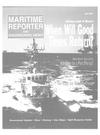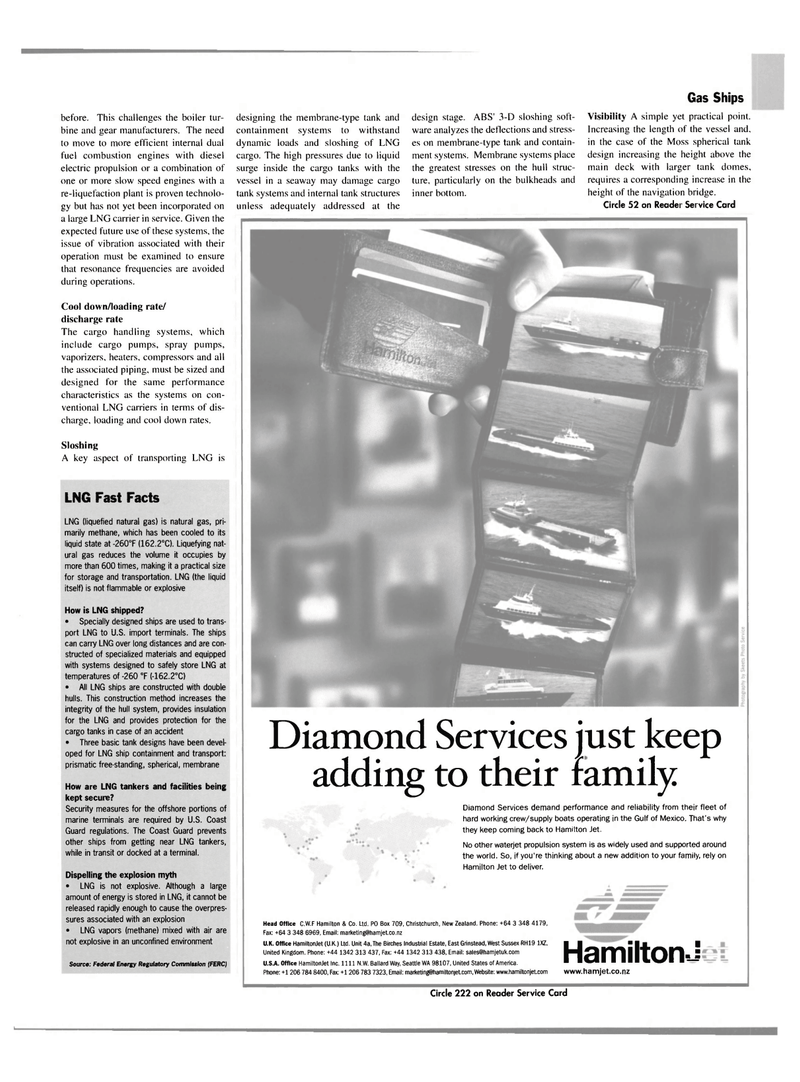
Page 49: of Maritime Reporter Magazine (April 2004)
Offshore Technology Yearbook
Read this page in Pdf, Flash or Html5 edition of April 2004 Maritime Reporter Magazine
LNG Fast Facts
LNG (liquefied natural gas) is natural gas, pri- marily methane, which has been cooled to its liquid state at -260°F (162.2°C). Liquefying nat- ural gas reduces the volume it occupies by more than 600 times, making it a practical size for storage and transportation. LNG (the liquid itself) is not flammable or explosive
How is LNG shipped? • Specially designed ships are used to trans- port LNG to U.S. import terminals. The ships can carry LNG over long distances and are con- structed of specialized materials and equipped with systems designed to safely store LNG at temperatures of -260 °F (-162.2°C) • All LNG ships are constructed with double hulls. This construction method increases the integrity of the hull system, provides insulation for the LNG and provides protection for the cargo tanks in case of an accident • Three basic tank designs have been devel- oped for LNG ship containment and transport: prismatic free-standing, spherical, membrane
How are LNG tankers and facilities being kept secure?
Security measures for the offshore portions of marine terminals are required by U.S. Coast
Guard regulations. The Coast Guard prevents other ships from getting near LNG tankers, while in transit or docked at a terminal.
Dispelling the explosion myth • LNG is not explosive. Although a large amount of energy is stored in LNG, it cannot be released rapidly enough to cause the overpres- sures associated with an explosion • LNG vapors (methane) mixed with air are not explosive in an unconfined environment
Source: Federal Energy Regulatory Commission (FERC)
Diamond Services just keep adding to their family
Diamond Services demand performance and reliability from their fleet of hard working crew/supply boats operating in the Gulf of Mexico. That's why they keep coming back to Hamilton Jet.
No other waterjet propulsion system is as widely used and supported around the world. So, if you're thinking about a new addition to your family, rely on
Hamilton Jet to deliver.
Head Office C.W.r Hamilton & Co. Ltd. PO Box 709, Christchurch. New Zealand. Phone: +64 3 348 4179,
Fax: +64 3 348 6969, Email: [email protected]
U.K. Office HamiltonJet (U.K.) Ltd. Unit 4a,The Birches Industrial Estate, East Grinstead, West Sussex RH19 1XZ,
United Kingdom. Phone: +44 1342 313 437, Fax: +44 1342 313 438, Email: [email protected]
U.S.A. Office HamiltonJet Inc. 1111 N.W. Ballard Way, Seattle WA 98107, United States of America.
Phone: +1 206 784 8400, Fax: +1206 783 7323, Email: [email protected], Website: www.hamiltonjet.comwww.hamjet.co.nz
HamiltonJ
Cool down/loading rate/ discharge rate
The cargo handling systems, which include cargo pumps, spray pumps, vaporizers, heaters, compressors and all the associated piping, must be sized and designed for the same performance characteristics as the systems on con- ventional LNG carriers in terms of dis- charge, loading and cool down rates.
Sloshing
A key aspect of transporting LNG is before. This challenges the boiler tur- bine and gear manufacturers. The need to move to more efficient internal dual fuel combustion engines with diesel electric propulsion or a combination of one or more slow speed engines with a re-liquefaction plant is proven technolo- gy but has not yet been incorporated on a large LNG carrier in service. Given the expected future use of these systems, the issue of vibration associated with their operation must be examined to ensure that resonance frequencies are avoided during operations. designing the membrane-type tank and containment systems to withstand dynamic loads and sloshing of LNG cargo. The high pressures due to liquid surge inside the cargo tanks with the vessel in a seaway may damage cargo tank systems and internal tank structures unless adequately addressed at the design stage. ABS' 3-D sloshing soft- ware analyzes the deflections and stress- es on membrane-type tank and contain- ment systems. Membrane systems place the greatest stresses on the hull struc- ture, particularly on the bulkheads and inner bottom.
Gas Ships
Visibility A simple yet practical point.
Increasing the length of the vessel and, in the case of the Moss spherical tank design increasing the height above the main deck with larger tank domes, requires a corresponding increase in the height of the navigation bridge.
Circle 52 on Reader Service Card
Circle 222 on Reader Service Card

 48
48

 50
50
